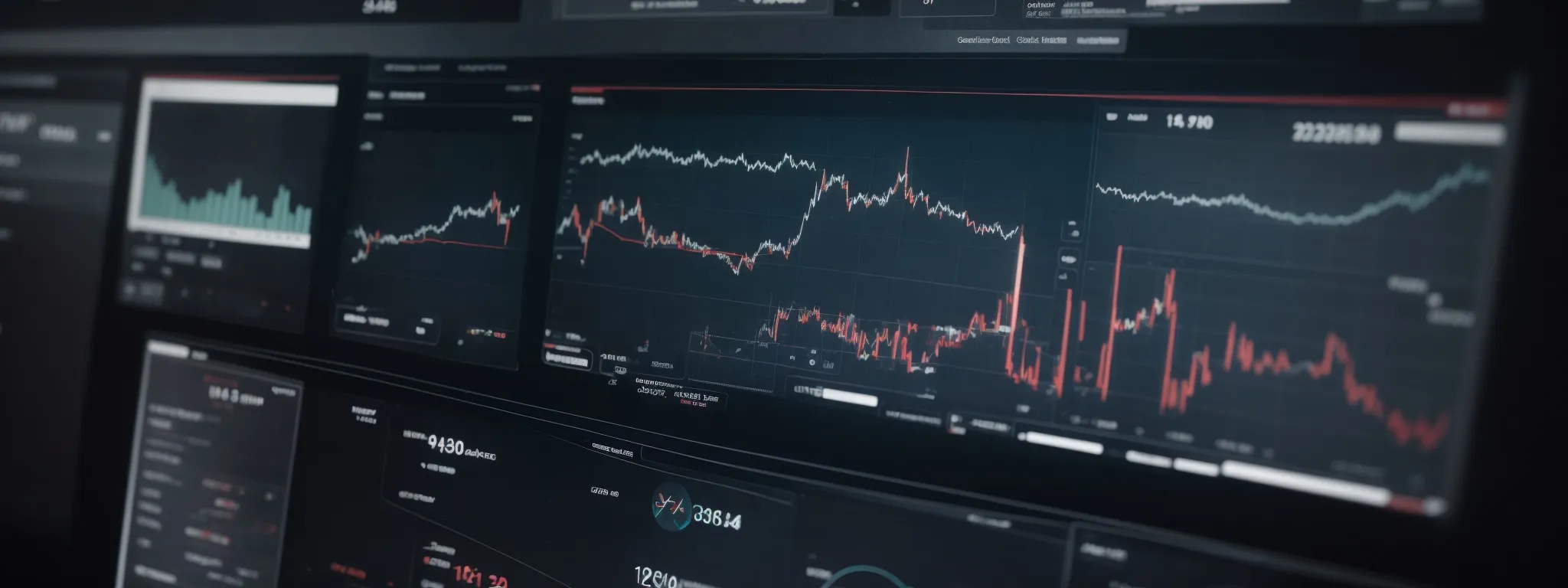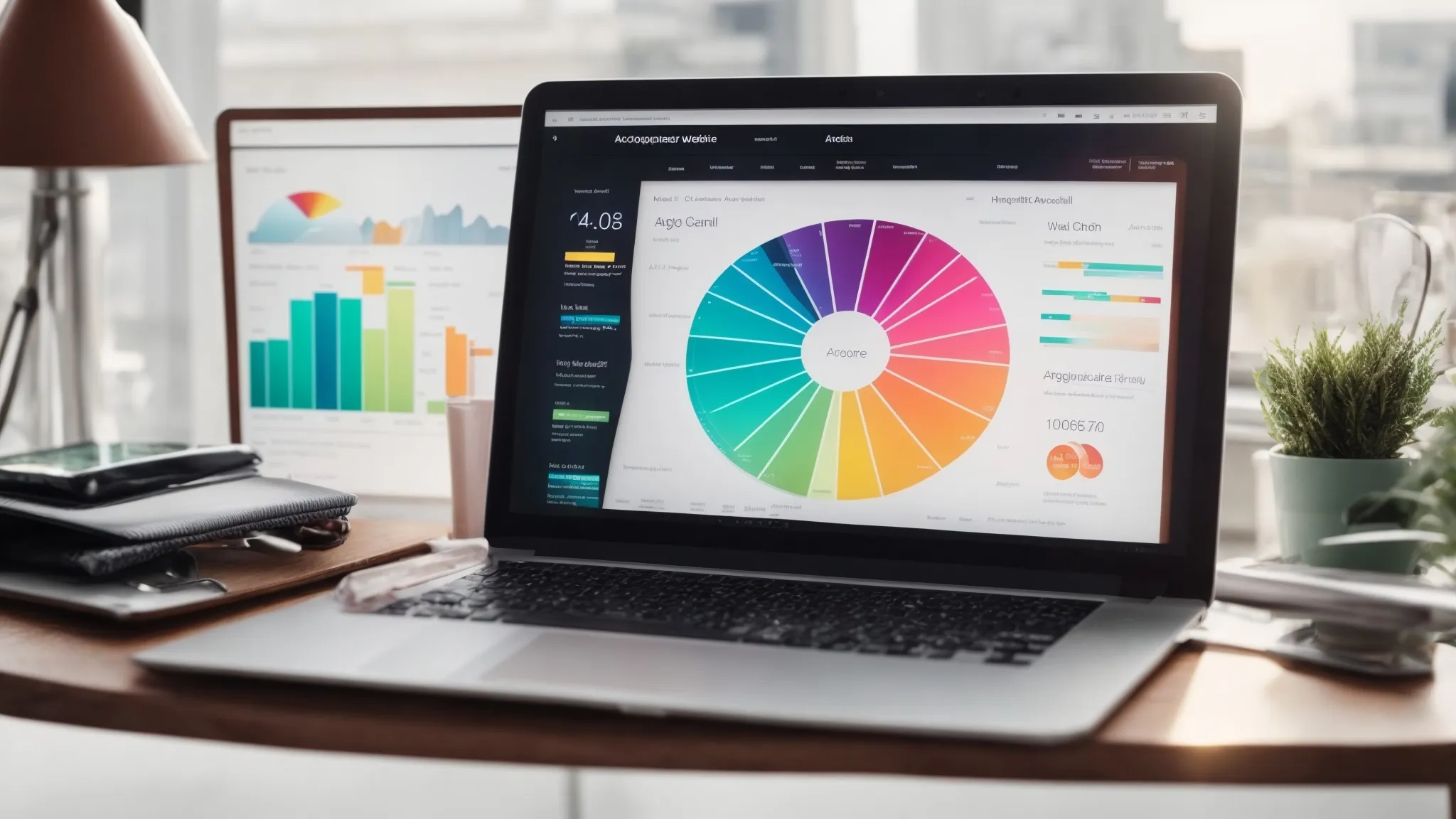How To Use Google Analytics
Mastering Google Analytics: A Comprehensive Guide To truly understand the performance of your website and the behaviors of your visitors, mastering Google Analytics is essential. This powerful […]
Mastering Google Analytics: A Comprehensive Guide
To truly understand the performance of your website and the behaviors of your visitors, mastering Google Analytics is essential.
This powerful tool can offer profound insights into user engagement, effectiveness of content, and the success of marketing campaigns.
Navigating the extensive features of Google Analytics can seem daunting, but with the right guidance, businesses can unlock a wealth of data to inform their digital strategy.
Whether you’re setting up tracking codes or dissecting complex reports, the knowledge gained from Google Analytics is invaluable for growth.
Keep reading to unlock the full potential of your website through meticulous Google Analytics mastery.
Key Takeaways
- Google Analytics Provides Valuable Insights Into User Behavior and Website Performance
- Proper Setup and Use of Google Analytics Can Inform Targeted Marketing Strategies and Content Optimization
- Custom Segments in Google Analytics Allow for Detailed Audience Analysis and More Personalized Marketing Approaches
- Integration With Google Ads and Tag Manager Enhances the Precision and Efficiency of Campaign Tracking
- Conversion Reports Are Essential for Understanding the Sales Funnel and Improving Conversion Rates
Setting Up Google Analytics for Your Website

In the digital age, the ability to scrutinize the flow of users through a website is a power that businesses leverage for growth and refinement.
Mastering Google Analytics lays a sturdy foundation for understanding visitor behaviors, thus enhancing strategic decisions.
Initiating this journey involves a series of critical steps, beginning with the creation or access to a Google Analytics account.
Subsequent to this, professionals are required to configure the specifics of the Analytics property, a vessel for the data pertinent to the chosen website or application.
Furthermore, a reporting view must be established to distill information into actionable insights.
The final piece of the setup is the implementation of a tracking code onto the website, a crucial action that serves as the genesis of data collection.
These initial undertakings serve as a preamble to unlocking the extensive capabilities of Google Analytics for website performance evaluation.
Create or Sign in to Your Google Analytics Account
To embark on the journey of analytics, one must initiate access by creating or logging into a Google Analytics account. This access point is essential for users seeking to analyze and optimize their web presence, serving as the gatekeeper for the wealth of data Google Analytics offers.
Once signed in, users are greeted by a dashboard where they can view existing data streams or add new ones to commence tracking. This dashboard is pivotal for users to navigate through the varied functionalities that Google Analytics provides, shaping the trajectory of future marketing campaigns and strategy refinements:
| Section | Description | Benefit |
|---|---|---|
| Data Stream Creation | Allows the addition of new websites or applications for tracking | Enables the expansion of analytics to cover multiple digital assets |
| User Interface Navigation | Access to a range of reports and insights from the dashboard | Fosters an understanding of user engagement and website performance |
| Campaign Tracking | Facility to monitor specific marketing initiatives | Yields actionable data for optimizing marketing strategies |
Set Up a Property in Your Analytics Account
Establishing a property within one’s Google Analytics account is akin to setting the stage for insights on a specific corner of the digital landscape. This property acts as a repository where all user interaction with the website or application is meticulously collated and analyzed.
The property setup is a testament to the user’s commitment to distill granular data into robust, actionable intelligence. It is where the process of capturing user interactions transitions from conceptual planning to actual, measurable events that inform business strategies.
Set Up a Reporting View in Your Property
Upon finalizing the property configuration in Google Analytics, the subsequent stride involves establishing a reporting view. This tailored perspective filters the incoming data, offering a clearer vantage point tailored to specific business requirements and objectives: a navigational beacon through the sea of metrics and user statistics.
- Customization of Data Presentation: Tailor the analytics interface to reflect the metrics that resonate with the organization’s goals.
- Creation of Segmented Views: Craft unique views to monitor different segments of traffic, enhancing targeted analysis.
- Filter Implementation: Apply filters to exclude irrelevant data or refine the data pool for more accurate analysis.
Executing these refinements within the reporting view not only streamlines the decision-making process but also ensures that stakeholders are privy to the data that truly drives business growth. It’s the meticulous art of tuning a complex instrument to amplify the harmony between the data captured and the insights required for strategic advancement.
Install Your Tracking Code on the Website
The tracking code is the lifeblood of Google Analytics, functioning as a silent sentinel that captures user interactions seamlessly. This unique snippet of JavaScript is placed into the code of each webpage, forging a link between the site and Google Analytics, a beacon that starts the meticulous work of gathering valuable data.
Professionals ensure the tracking code’s installation is precise and verified, as even a minor oversight can disrupt the flow of data and skew insights. With vigilance, they confirm the code’s presence on every page, safeguarding the integrity of the information funneling into Google Analytics and setting the stage for a treasure trove of analytical opportunities.

Navigating the comprehensive interface of Google Analytics reveals a universe of data that, when interpreted correctly, can translate into actionable insights driving informed business decisions.
From the command center of the dashboard, glances into real-time reports illustrate a website’s pulse.
Managers keenly observe the flow of audience analytics, unlocking the dynamics of user demographics to tailor content strategies accordingly.
The quest to understand traffic origins opens a chapter in acquisition analytics, while the scrutinization of behavior reports provides a deep look into page performance.
Each segment of this data mosaic, when pieced together, equips businesses with the knowledge to optimize their digital footprint and steer their online prowess toward greater effectiveness.
Overview of the Dashboard and Real-Time Reports
The Google Analytics dashboard offers a control panel that is both dynamic and intuitive, empowering users to monitor an array of data at a glance. Within this digital command center, the real-time reports serve as the organization’s pulse, showcasing live user activity and interactions as they unfold on the website.
Accessing these reports enables a direct view into current traffic, revealing immediate insights into user behavior, active pages, and the effectiveness of ongoing campaigns. This immediacy of information is a vital tool for marketers and webmasters intending to adapt swiftly to user trends and preferences:
- Live Traffic Monitoring: Gauge the instant impact of campaigns and site changes.
- User Engagement Insights: Understand how visitors interact with your website in real-time.
- Resource Allocation Optimization: Make informed decisions on where to focus efforts based on live data.
Understanding Audience Analytics and User Demographics
Unveiling the layers of audience analytics within Google Analytics, businesses uncover the multifaceted aspects of their user demographics. The platform’s detailed metrics offer revelations about age, gender, interests, and geographical locations, painting a vivid portrait of who visitors truly are.
Equipped with these insights, companies tailor their marketing strategies to resonate deeply with their actual audience. Crafting messaging that aligns with user preferences turns casual browsers into loyal customers, enhancing the user experience and strengthening brand affinity:
- Demographic Segmentation: Break down data by age, gender, and location for targeted outreach.
- Interest Profiling: Analyze user interests to inform content creation and advertising initiatives.
- Geographic Tailoring: Customize product offerings and campaigns to suit regional tastes and demands.
Discovering the Acquisition and Traffic Sources
The exploration of acquisition and traffic sources via Google Analytics provides organizations with a transparent view into where visitors originate before landing on their digital doorstep. By examining channels such as organic search, paid campaigns, social media, and referrals, companies develop a nuanced understanding of how different strategies contribute to website traffic.
Through this analysis, the value of each acquisition channel is illuminated, empowering decision-makers to allocate resources effectively and fine-tune marketing efforts. The scrutiny of traffic sources becomes a strategic point in shaping initiatives aimed at engaging with potential customers more successfully and increasing overall conversion rates.
Analyzing Behavior Reports for Page Performance
The behavior reports in Google Analytics serve as a strategic canvas, detailing how visitors interact with a website’s content. By meticulously analyzing page views, unique views, average time on page, and bounce rates, businesses glean insights into page performance, highlighting areas ripe for enhancement.
Experts scrutinize these reports, determining the efficacy of website structure and content to engage users effectively. Adjustments to the digital platform are then informed by these analytics, allowing for an iterative approach to optimizing the user journey and fostering higher engagement levels.
Defining Goals and Conversion Tracking

In an environment where actionable insights translate to competitive advantage, setting precise objectives within Google Analytics is vital for any business intent on tracking progress and success.
Understanding the various goal types that reflect different user actions is critical for capturing the essence of customer engagement and for mapping conversion paths effectively.
As organizations seek to refine their digital strategies, mastering the art of setting up goals and monitoring their completions becomes a crucial endeavor.
This process not only illuminates the efficacy of marketing campaigns and user interactions but also delineates a clear trajectory for achieving targeted business outcomes.
Setting Up Goals to Track Conversions
Configuring goals in Google Analytics is a pivotal task, enabling businesses to assess how effectively their website fosters conversions. This process involves specifying parameters that, once met by a user’s action, are recorded as accomplishments, thereby translating complex user behaviors into digestible success metrics.
Conversion goals may range from tracking form submissions to measuring the frequency of product purchases. Astute professionals utilize this feature to monitor predefined objectives, thereby quantifying the success rate of user journeys and the potency of digital strategies in advancing business objectives.
Understanding the Goal Types Available
Google Analytics furnishes users with a suite of goal configurations, each designed to align with an array of conversion types. Destination goals prove valuable for tracking visits to a thank you or confirmation page after completing an action, whereas duration goals focus on the amount of time spent on a site, highlighting user engagement levels.
Further customizing the tracking experience, event goals capture specific interactions with content, such as downloads, video plays, and button clicks, and pages per session goals measure the depth of user navigational paths. These goal types, when used judiciously, provide a comprehensive view of the conversion funnel, guiding strategic enhancements.
Monitoring Goal Completions and Conversion Paths
Throughout the intricate journey of Google Analytics, monitoring goal completions stands as the beacon that guides businesses through the murky waters of conversion tracking. Frequent examination of these metrics sheds light on the effectiveness of user pathways, pinpointing where users convert or fall short of the intended objectives, thus allowing strategists to refine the conversion process with precision.
Furthermore, analyzing conversion paths gives insight into the sequences of touchpoints influential in driving a user toward a goal. This crucial analysis aids companies in optimizing each step of the user’s journey, ensuring a seamless and enticing route toward conversion:
| Touchpoint | Influence on User | Role in Conversion Path |
|---|---|---|
| Landing Page | First impression and engagement | Initiates user journey and interest |
| Product Information | Provides detailed benefits | Builds value proposition and desire |
| Call to Action | Prompts user action | Catalyst for conversion event |
| Checkout Process | Simplifies transaction completion | Finalizes the conversion and captures success |
Exploring Audience Segmentation Techniques

Delving into the realm of audience segmentation within Google Analytics equips organizations with a profound tool for understanding and catering to the intricacies of their user base.
Constructing custom segments empowers firms to concentrate their analysis on specific user groups, enabling the deployment of highly targeted strategies.
Leveraging demographics and interests data, professionals can tailor their approaches, ensuring relevance and resonance with each distinct user segment.
By dissecting user behavior through the lens of these bespoke groupings, enterprises can uncover patterns of engagement, enabling them to fine-tune user experiences and sharpen the focus of their initiatives, thereby fostering a more personalized and impactful user interaction.
Creating Custom Segments for Targeted Analysis
In the pursuit of harnessing Google Analytics’ full potential, businesses often turn their attention towards the creation of custom segments. These segments allow analysts to isolate and examine subsets of data, enabling precise scrutiny of user activity and behavior specific to certain criteria or patterns of interest.
Custom segments transcend basic analytics by offering the flexibility to focus on the variables that matter most to an organization, such as specific demographics, behavior, or traffic sources. This targeted analysis not only refines the understanding of audience characteristics but also drives strategic decisions geared towards more impactful and efficient marketing efforts.
Using Demographics and Interests Data Effectively
Effectively leveraging demographics and interests data gleaned from Google Analytics can transform a company’s approach to the market. By analyzing these facets, businesses gain an acute awareness of who their audience is and what motivates their actions, empowering the customization of content and advertising strategies to resonate on a personal level.
Understanding the diversity within an audience leads to the optimization of resources, ensuring marketing efforts are directed with precision. Segmentation based on detailed demographic data and user interests serves as a compass, directing campaigns to those most likely to engage and convert:
- Segmenting by Age and Gender: Tailors marketing messages to better suit the life stage and preferences of various user groups.
- Interest-Centric Targeting: Aligns product offerings and advertisements with users’ hobbies, behaviors, and consumption habits, fostering relevancy.
- Geographic Relevance: Customizes promotions and product availability to reflect regional distinctions and cultural nuances.
Analyzing User Behavior by Segments
Professionals employ the segmentation capabilities of Google Analytics to disaggregate the aggregate user data, revealing nuanced behaviors of specific user groups. This analysis illuminates the pathways and interactions that different segments have with website content, enabling the refinement of user experiences to target the preferences and needs of each group effectively.
By dissecting the engagement levels and conversion efficiency across various segments, analysts identify trends and opportunities for optimization. Such insights guide the personalization of user interactions, ensuring that each segment’s experience is carefully curated to increase overall satisfaction and conversion rates.
Utilizing Google Analytics Reports for Insights

In the intricate tapestry of digital analytics, Google Analytics reports stand out as critical tools for deciphering the flow of traffic, the efficacy of content, and the mechanics of conversion funnels.
As professionals navigate through the data-rich environment provided by these reports, they gain unparalleled insights into acquisition patterns, content engagement, and user journey effectiveness.
Mastery of acquisition, behavior, and conversion reports is essential for any organization aiming to refine its online presence and align its strategies with the nuanced behaviors of its audience.
These reports, when analyzed with expertise, become luminous beacons guiding businesses towards data-driven decision-making and optimized digital marketing success.
Delving Into Acquisition Reports for Traffic Sources
Acquisition reports in Google Analytics are indispensable sources of intelligence, detailing the variety of pathways users take to arrive at a website. Such reports categorize traffic sources, offering clarity on the performance of search engines, social networks, direct entries, and referral sites.
This focused insight allows businesses to appraise the impact of their marketing efforts across various channels and streamline their strategies to capitalize on the most fruitful sources of traffic. Discerning the nuances of these reports is paramount for optimizing acquisition strategies and driving targeted website traffic:
- Assess effectiveness of SEO and PPC campaigns.
- Gauge the influence of social media engagement.
- Determine the value of referral partnerships and affiliate links.
By meticulously analyzing acquisition reports, companies enhance their understanding of campaign performance, tailoring their investments to channels that promise the highest returns. It becomes possible to reinforce successful tactics, reevaluate underperforming ads, and uncover hidden opportunities for growth.
Interpreting Behavior Reports to Optimize Content
Delving into behavior reports provided by Google Analytics empowers businesses to hone their content strategies with precision. The ability to parse through data such as time spent on page and exit rates furnishes marketers with the insights necessary to enhance the user experience, ensure content relevance, and reduce bounce rates, thus firmly embedding content effectiveness at the core of website optimization efforts.
Through the vigilant interpretation of page performance metrics, companies can identify content that captivates an audience as well as areas that may benefit from refinement or complete restructuring. This analytical approach forms the bedrock upon which content can be sculpted to meet the evolving interests and behaviors of users, cementing the role of behavior reports as a pivotal asset in the realm of content optimization.
Understanding Conversion Reports for Funnel Analysis
Conversion reports in Google Analytics are instrumental for dissecting the effectiveness of each step in the sales funnel. These reports spotlight where prospects drop off and where they convert, offering crucial insights into the efficacy of the funnel’s design and execution.
Utilizing these findings, organizations can reconstruct their funnels to facilitate smoother transitions from awareness to conversion. Strategists enact changes that address friction points and bolster sections that drive conversions:
- Analyze entry points to ensure relevance and engagement.
- Review content interaction to gauge interest levels.
- Inspect drop-off rates to identify potential barriers.
- Test call-to-action elements for effectiveness.
- Optimize checkout processes for ease of completion.
Embracing the data from conversion reports allows businesses to refine their approach, aligning it closely with the customer’s expectations and demands. This optimization is critical to nurturing leads towards a commitment, thereby elevating the conversion rate and driving revenue growth.
Integrating Google Analytics With Other Tools

The synergy between Google Analytics and other essential digital marketing tools fortifies the comprehensive insights that businesses can extract from their online endeavors.
By connecting Google Analytics with Google Ads, marketers streamline advertising data, harnessing granular insight into the performance of their paid search efforts.
The integration with Google Tag Manager simplifies the management of tracking tags, providing a more efficient framework for data collection.
Furthermore, the implementation of UTM parameters enables analysts to trace the effectiveness of social media and email campaigns, ensuring every facet of digital strategy is measured and optimized.
This cohesion among tools allows for a seamless workflow, enhancing the clarity and precision of data-driven decisions.
Linking Google Analytics With Google Ads for Advertising Data
The integration of Google Analytics with Google Ads is a strategic move that unlocks a unified view of customer behavior and advertising performance. By linking these platforms, professionals can trace the customer journey from initial ad impression to conversion, bridging the gap between traffic acquisition and subsequent user actions on the website.
This convergence facilitates a heightened understanding of the return on investment for advertising spend, allowing campaign managers to adjust bids, tailor ad creatives, and optimize landing pages based on comprehensive data. It equips marketers with the intelligence to maximize the impact of their Google Ads campaigns through informed, data-backed decisions.
Using Google Tag Manager Alongside Google Analytics
Implementing Google Tag Manager in conjunction with Google Analytics revolutionizes the tracking management process, enabling rapid updates and deployment of tracking tags without the need for extensive coding or IT intervention. This fusion empowers marketers to oversee a multitude of analytics and marketing tags, streamlining the data collection process for more accurate analysis and reporting.
By utilizing Google Tag Manager, professionals can enhance the precision of their data in Google Analytics, ensuring that every user interaction is captured meticulously. This integration establishes a robust framework for the efficient harvesting of data, as tags can be tested, edited, and implemented swiftly, providing a real-time ability to adapt to the ever-evolving digital landscape.
Tracking Social Media and Email Campaigns With UTM Parameters
Employing UTM parameters is a methodical approach to track the specifics of traffic originating from social media campaigns and email newsletters. By appending these query strings to URLs, marketers can categorize and monitor the performance of different campaigns within Google Analytics with a high degree of granularity.
This precise tracking mechanism is momentous for comprehending the direct impact of each campaign on user behavior and website engagement. Strategists judiciously analyze the data to refine campaign efficacy and heighten the return on investment for digital marketing efforts:
- Segment campaigns for focused analysis.
- Identify the most effective channels driving traffic.
- Optimize marketing strategies based on user response data.
Conclusion
Mastering Google Analytics is an essential undertaking for businesses aiming to thrive in the digital landscape.
This comprehensive guide underscores the crucial steps involved in setting up and navigating Google Analytics to glean actionable insights into website performance.
From creating an account, setting up properties, and implementing tracking codes, to diving into reports and integrating with other tools, each element plays a pivotal role in painting a coherent picture of user behavior and campaign effectiveness.
By mastering Google Analytics, businesses empower themselves to make data-driven decisions that can optimize marketing strategies, enhance user engagement, and ultimately drive conversions and growth.
It is clear that leveraging the full spectrum of capabilities within Google Analytics is key to not just understanding but also maximizing digital presence and impact.















































































